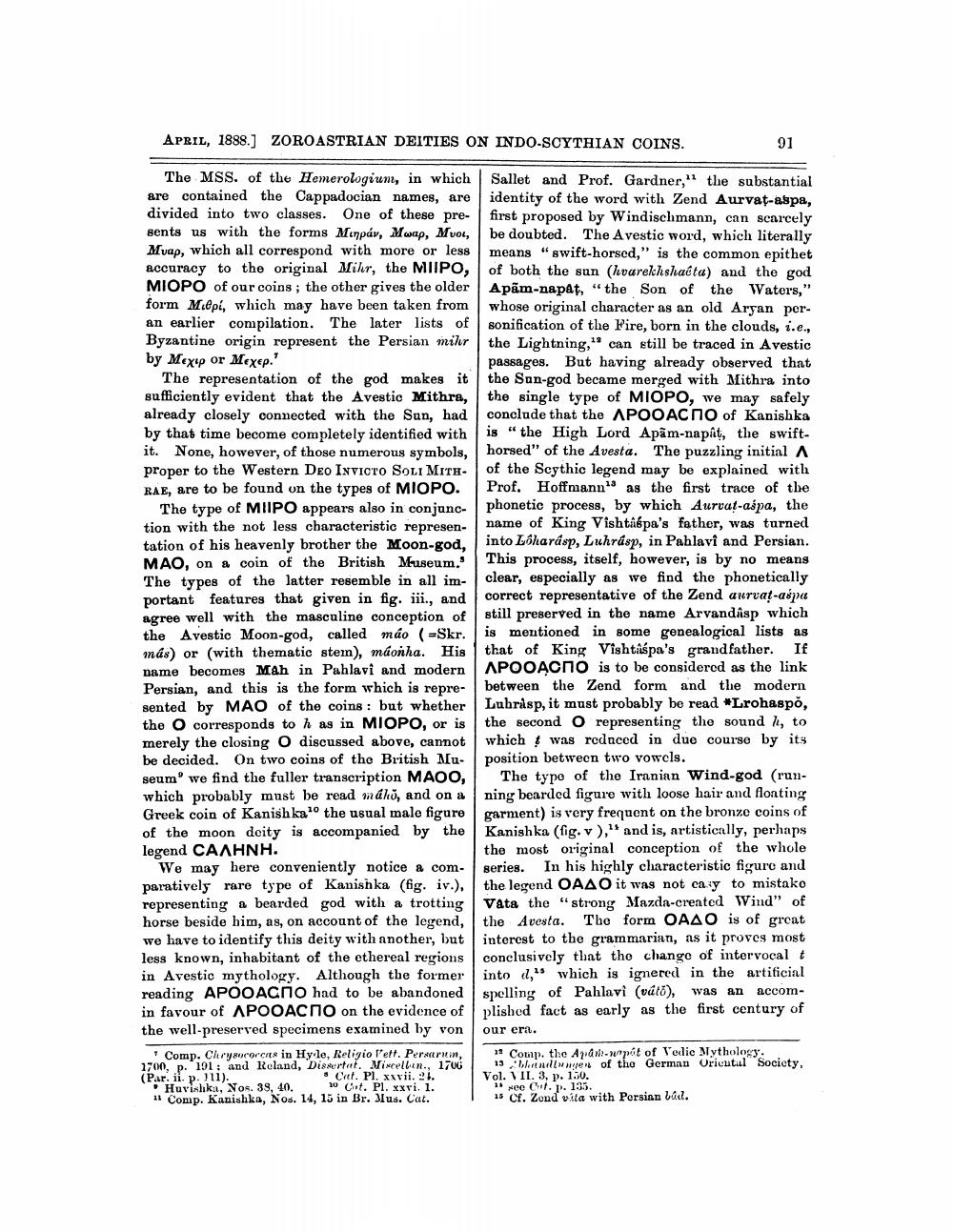________________
APRIL, 1888.] ZOROASTRIAN DEITIES ON INDO-SCYTHIAN COINS.
91
The MSS. of the Hemerologium, in which Sallet and Prof. Gardner," the substantial are contained the Cappadocian names, are identity of the word with Zend Aurvat-aspa, divided into two classes. One of these pre- first proposed by Windischmann, can scarcely sents us with the forms Minpáv, Mwap, Muou, be doubted. The A vestic word, which literally Mvap, which all correspond with more or less means “swift-horsed," is the common epithet accuracy to the original Mihr, the MIIPO, of both the sun (harekhshafta) and the god MIOPO of our coins; the other gives the older Apām-napat, “the Son of the Waters," form Miepi, which may have been taken from whose original character as an old Aryan po an earlier compilation. The later lists of sonification of the Fire, born in the clouds, i.e., Byzantine origin represent the Persian miler the Lightning," can still be traced in Avestic by Mexup or Mexep.'
passages. But having already observed that The representation of the god makes it the Sun-god became merged with Mithra into sufficiently evident that the Avestic Mithra, the single type of MIOPO, we may safely already closely connected with the Sun, had conclude that the APOOAC No of Kanishka by that time become completely identified with is "the High Lord Apam-napat, the swiftit. None, however, of those numerous symbols, horsed" of the Avesta. The puzzling initial A proper to the Western DEO INVICTO SOLI MITH. of the Scythic legend may be explained with RAE, are to be found on the types of MIOPO. Prof. Hoffmann" as the first trace of the
The type of MIIPO appears also in conjunc- phonetic process, by which Aurvat-aspa, the tion with the not less characteristic represen
name of King Vishtaspa's father, was turned tation of his heavenly brother the Moon-god, into Lóharásp, Luhrásp, in Pahlavi and Persian. MAO, on a coin of the British Museum." This process, itself, however, is by no means The types of the latter resemble in all im- clear, especially as we find the phonetically portant features that given in fig. ij., and correct representative of the Zend aurvat-aspa agree well with the masculine conception of still preserved in the name Arvandisp which the Avestic Moon-god, called máo (=Skr. is mentioned in some genealogical lists as más) or (with thematic stem), máonha. His that of King Vishtaspa's grandfather. If name becomes Mah in Pahlavi and modern APOOĄCNO is to be considered as the link Persian, and this is the form which is repre- between the Zend form and the modern sented by MAO of the coins : but whether Lubrisp, it must probably be read #Lrohaspo, the corresponds to h as in MIOPO, or is the second o representing the sound li, to merely the closing O discussed above, cannot which was reduced in due course by its be decided. On two coins of the British Mu- position between two vowels. seum we find the fuller transcription MAOO, The typo of the Iranian Wind-god (runwhich probably must be read máho, and on a ning bearded figure with loose hair and floating Greek coin of Kanishkathe usual male figure garment) is very frequent on the bronze coins of of the moon deity is accompanied by the Kanishka (fig. v)," and is, artistically, perhaps legend CAAHNH.
the most original conception of the whole We may here conveniently notice a com- series. In his highly characteristic figure and paratively rare type of Kanishka (fig. iv.), the legend OAAO it was not cay to mistako representing a bearded god with a trotting Vata the "strong Mazda-created Wind" of horse beside him, as, on account of the legend, the Avesta. The form OAAO is of great we have to identify this deity with another, but interest to the grammarian, as it proves most less known, inhabitant of the ethereal regions conclusively that the change of intervocal t in Avestic mythology. Although the former into e," which is ignered in the artificial reading APOOACNO had to be abandoned spelling of Pahlavi (váto), was an accomin favour of APOOACNO on the evidence of plished fact as early as the first century of the well-preserved specimens examined by von our era.
Comp. Chrysocorcits in Hyle, Religio lett. Persariin, Comp. the Apodi-wipit of Vedic Mythology, 1700, p. 191: and Roland, Dissertat. Mincelben., 1706 13 Wellen of the German Oricutul Society, (Par. il. p. 111).
Cat. Pl. xxvii. 21. Vol. VII. 3. p. 1.50. . Huvishku, Nos. 39, 40. 10 Chet. Pl. xxvi. 1.
1nee C . p. 135. 11 Comp. Kanishka, Nos. 14, 15 in Br. Mus. Cat.
15 Cf. Zond vita with Porsian bau.




